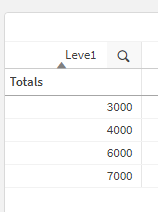Unlock a world of possibilities! Login now and discover the exclusive benefits awaiting you.
- Qlik Community
- :
- Forums
- :
- Analytics
- :
- New to Qlik Analytics
- :
- Re: Total values in table
- Subscribe to RSS Feed
- Mark Topic as New
- Mark Topic as Read
- Float this Topic for Current User
- Bookmark
- Subscribe
- Mute
- Printer Friendly Page
- Mark as New
- Bookmark
- Subscribe
- Mute
- Subscribe to RSS Feed
- Permalink
- Report Inappropriate Content
Total values in table
Hi Gurus,
I need to get the totals of some valies in the Column
ex:
I got a table with couple of columns and In one column I have this values:
Column1 column2
A 20
B 30
C 40
A 10
Now SUm of column2 is 100
but i need to show only sum of A 20+10 = 30
any suggestions please
Thanks,
Kumar
Accepted Solutions
- Mark as New
- Bookmark
- Subscribe
- Mute
- Subscribe to RSS Feed
- Permalink
- Report Inappropriate Content
Hello,
I am not 100% sure that I understood your requirement.
You have stated: "now I want sum where level 1 =3000 i.e 6000", from which I understand that you want to sum all the values of field "Leve1" where the amount is equal to "3000". Therefore, based on the given dataset you should get the outcome "6000".
Then you have stated: "I need to show in a table .", which I am not sure how the data should appear on the final table.
1. Based on the new details I have loaded the dataset and added "Leve1" as dimension in the table:
2. Now I have added a measure expression: =Sum(TOTAL {<Leve1={'3000'}>}Leve1) and the outcome is:
It only sum up all the values of field Leve1 where the value is 3000 and displays on the table, so ideally it covers what you need.
However, in case I am still missing some details, then I would recommend:
- Create a simple table with the data in EXCEL and share with us a screenshot
- Then create another table that will represent the expected outcome and share again the screenshot
- This will allow us to understand exactly the use case scenario
- Mark as New
- Bookmark
- Subscribe
- Mute
- Subscribe to RSS Feed
- Permalink
- Report Inappropriate Content
Hello,
Perhaps you can use set analysis? For example:
You can use the expression: =Sum(TOTAL {<Column1={'A'}>}Column2) and the output is:
As you can see only the number 30 is presented, which is the sum of all A values from Column2.
I hope that this information was helpful. In case I have misunderstood the use case scenario, please elaborate in details by providing additional information. However, if it has helped you resolve the issue, addressed your concerns or at least pointed you in the right direction, please mark it as Accepted Solution to give further visibility to other community members.
- Mark as New
- Bookmark
- Subscribe
- Mute
- Subscribe to RSS Feed
- Permalink
- Report Inappropriate Content
Sorry Andrei,
I explained the scenario in a wrong way ..plz bear with me as I am new to QS
I have a Column Leve 1
Leve1
3000
4000
3000
6000
7000
now I want sum where level 1 =3000 i.e 6000 I need to show in a table .
Advance Thanks
Kumar
- Mark as New
- Bookmark
- Subscribe
- Mute
- Subscribe to RSS Feed
- Permalink
- Report Inappropriate Content
Hello,
I am not 100% sure that I understood your requirement.
You have stated: "now I want sum where level 1 =3000 i.e 6000", from which I understand that you want to sum all the values of field "Leve1" where the amount is equal to "3000". Therefore, based on the given dataset you should get the outcome "6000".
Then you have stated: "I need to show in a table .", which I am not sure how the data should appear on the final table.
1. Based on the new details I have loaded the dataset and added "Leve1" as dimension in the table:
2. Now I have added a measure expression: =Sum(TOTAL {<Leve1={'3000'}>}Leve1) and the outcome is:
It only sum up all the values of field Leve1 where the value is 3000 and displays on the table, so ideally it covers what you need.
However, in case I am still missing some details, then I would recommend:
- Create a simple table with the data in EXCEL and share with us a screenshot
- Then create another table that will represent the expected outcome and share again the screenshot
- This will allow us to understand exactly the use case scenario
- Mark as New
- Bookmark
- Subscribe
- Mute
- Subscribe to RSS Feed
- Permalink
- Report Inappropriate Content
Thanks.


